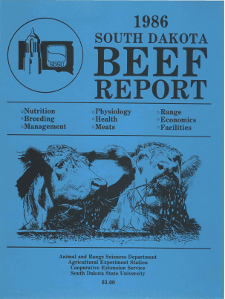
South Dakota Beef Report, 1986
Document Type
Report
Report Number
86-13
Publication Date
1986
Keywords
cattle evaluation, expected progeny difference
Summary
Use of artificial insemination permits some bulls to have offspring evaluated in more than one herd. Such bulls serve as benchmarks for comparison or links between herds. For some breeds, sufficient links exist between herds that current technology may provide valid genetic comparisons between cattle from different herds, as well as within-herd comparisons. The current industry standard expression for reporting relative genetic merit of beef cattle in national evaluations is expected progeny difference (EPD). The EPD for a sire represents the expected difference in performance of a sire’s offspring when compared t o the average offspring performance of all sires evaluated. A corresponding accuracy value, reflecting the amount of information (pedigree performance, individual performance, offspring performance, etc.) on which the EPD value is based, is generally reported with each EPD value. Expected progeny difference values can be calculated not only for bulls listed in sire summaries, but also for cows, young bulls and even planned matings. EPDs for nonparents generally have low accuracy values compared to EPDs for parents. generally have low accuracy values compared t o EPDs for parents.
Number of Pages
6
Type
text
Format
application/pdf
Language
en
Publisher
South Dakota State University
Rights
Copyright © 1986 South Dakota State University
Recommended Citation
Marshall, D.M., "National Beef Cattle Genetic Evaluation" (1986). South Dakota Beef Report, 1986. 14.
https://openprairie.sdstate.edu/sd_beefreport_1986/14
